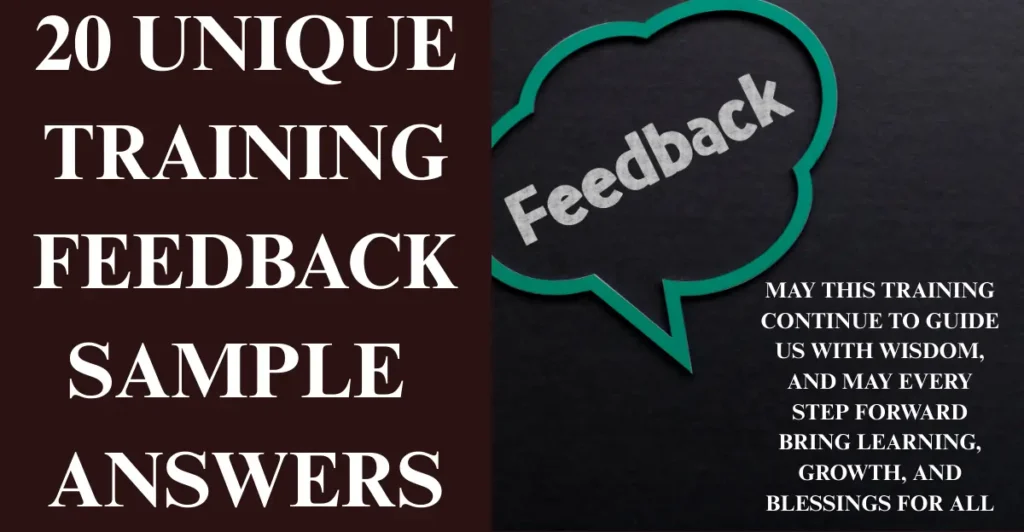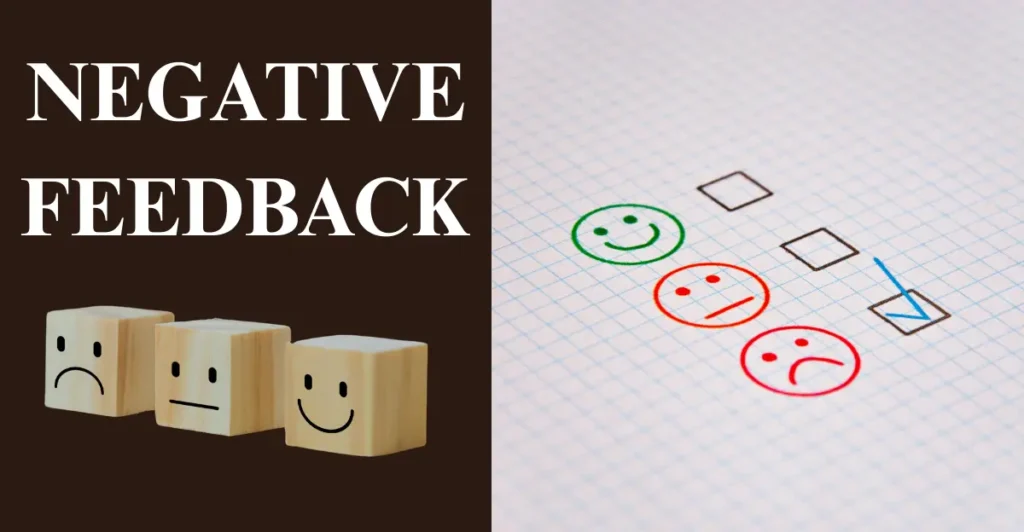Discover how detailed training feedback sample answers provide a clear guide for continuous improvement and growth while strengthening learning outcomes. With constructive and actionable feedback, training programs become more effective, empowering learners and enhancing instructional effectiveness. Apply these strategies today to achieve meaningful progress and lasting results.

Table of Contents
How To Write Feedback About Trainer

When writing feedback about a trainer, it is important to recognize their critical role in facilitating learning and development within an organization, as excellent feedback should highlight qualities such as communication, interpersonal skills, ability to be engaging, and delivering effective training programs; by acknowledging a thorough understanding of the subject matter, being well-prepared, and how trainers communicate clearly, address questions effectively, and create a significant impact, one ensures the constructive nature of the response, since beneficial feedback allows them to refine their approach, improve performance, and use detailed feedback as a tool to support growth that enhances the overall training experience for employees and trainees.
In my years of conducting and reviewing training programs, I noticed that when trainers received detailed feedback emphasizing their preparation, clarity, and adaptability, they were able to refine their delivery and better engage participants. I have personally witnessed how this type of constructive input transformed average sessions into highly impactful ones, leaving both employees and trainees with a deeper sense of achievement and practical growth.
20 Unique Training Feedback Sample Answers

Here are the 20 unique training feedback sample answers that can enhance learning and development through constructive and actionable remarks, ensuring continuous improvement in training:
Positive feedback

By acknowledging the trainer’s enthusiasm and dedication, learners appreciate the highlighting of their ability to make sessions engaging, easy to follow, and supported with real-world examples and interactive activities that help participants understand and apply concepts effectively, while incorporating relevant elements boosts success rates and enhances the overall learning experience.
Constructive feedback

Offering constructive feedback on the thoroughness of the material, pace, and delivery helps refine the use of slides that may feel cluttered or difficult to read, and encouraging them to simplify visuals enhances effectiveness; by adjusting when the presentation feels slow and ensuring questions are adequately addressed, trainers can refine their approach and improve performance in future sessions.
Negative feedback

Providing negative feedback can highlight areas where material felt disorganized, lacking clear progression, or where the trainer seemed unprepared and stumbled on words, thereby impacting clarity and conciseness; this input encourages them to organize ideas better, prepare thoroughly, and enhance effectiveness for improved future performance.
Positive feedback
A positive feedback approach can highlight the energy, enthusiasm, and dedication the trainer demonstrates in sessions, commending their ability to keep learners engaged with practical tips and insights that can be applied effectively at work, which contributes to success, motivates participants, and reinforces a strong commitment to impactful learning.
Constructive feedback
When giving constructive feedback, addressing the trainer’s voice being too monotone and suggesting they vary tone with storytelling and relevant examples makes content more engaging and informative, while also improving their ability to connect with participants, which ultimately enhances the effectiveness of training.
Negative feedback
Sharing negative feedback about a training session that felt unhelpful, unengaging, or delivered with uninspiring delivery, dry visuals, and weak activities can guide trainers to adjust their approach, add interactive elements, and make sessions more effective for better audience engagement and stronger overall impact.
Positive feedback
Delivering positive feedback by commending a trainer’s fantastic presentation, enthusiasm, and energetic style while highlighting their practical strategies and specific insights shows how they effectively address needs, and this praise for their excellent skills not only contributes to success but also boosts morale and strengthens the commitment to high-quality sessions.
Constructive feedback
Useful constructive feedback might address jargon or technical terms that were unfamiliar to the audience, suggesting the simplifying of language to make it more accessible; by creating opportunities for discussion, trainers can adjust their approach so that participants better understand the material, which improves engagement and effectiveness of sessions.
Negative feedback
Offering negative feedback when a presentation feels unorganized, scattered, and difficult for the audience to follow highlights the need for better structure, ensuring ideas flow with clear, concise progression and the trainer can deliver engaging sessions that improve learner outcomes.
Positive feedback
Sharing positive feedback that emphasizes the trainer’s enthusiasm, energy, and dedication during the session, along with their use of practical strategies and real-world examples, helps learners grasp concepts effectively while recognizing these strengths motivates participants and enhances the training experience with relevant and actionable practices.
Sarcastic feedback
Sometimes sarcastic feedback is given when a presentation comes across with a monotonous voice delivery that feels sleep-inducing, turning a riveting topic into hours-long boredom, which can be exaggerated as a push for adopting a more dynamic approach that keeps learners engaged and sessions more effective.
Blunt feedback
Using blunt feedback, pointing out that a presentation was dry, lacked engaging content, and failed to capture interest shows the need for trainers to improve skills, reduce monotony, and adopt a dynamic, interactive approach, offering straightforward actionable feedback that can drive impactful changes and enhance sessions.
Passive-aggressive feedback
Some passive-aggressive feedback notes that while the training was informative, it only covered basic concepts and didn’t keep the audience sufficiently engaged, subtly suggesting the need for more interactive activities, while still addressing concerns openly with actionable insights to enhance training effectiveness.
Over-the-top positive feedback
An over-the-top positive feedback style describes training as incredible, life-changing, and a masterclass with enthusiasm so contagious it feels like conquering the world, highlighting exceptional aspects while reminding trainers to keep balancing realistic observations to ensure continuous improvement and sustained success.
Empathetic feedback
With empathetic feedback, one can appreciate the effort while noting that parts of the training felt flat or dry, and adding more interactive elements, activities, and visuals could address these issues and make sessions more dynamic, engaging, and significantly effective in improving participant satisfaction.
Diplomatic feedback
Providing diplomatic feedback focuses on informative training with valuable insights while gently suggesting improvement in presentation and delivery, such as adding interactive discussions to increase engagement; this way, questions are addressed and skills refined, striking the right balance for a more successful session.
Complimentary feedback
Complimentary feedback celebrates a training session as informative, acknowledging the considerable effort in creating and explaining content, and appreciating the trainer’s ability to break down complex concepts into something easy to understand; this not only highlights deep knowledge but also amplifies effectiveness with a thoughtful presentation.
Short and sweet feedback
A short and sweet feedback response like “Thanks for the informative training, it covered what I needed and was concise yet effective” shows how even brief comments can make a strong impact and help participants more easily retain and apply information.
Detailed feedback
Detailed feedback often appreciates the thoroughness of the material and the relevant points covered, while noting that the pace felt slow for some participants; suggesting adjustments can enhance delivery by maintaining interest, balancing thoroughness, and ensuring an engaging, useful session.
Positive and encouraging feedback
Offering positive and encouraging feedback by highlighting the enthusiasm of the training, the fantastic session, and its accessible nature encourages continued improvement; the impressive presentation, positive tone, and enthusiastic delivery boost morale and create motivation for future sessions, building momentum.
In my experience conducting training and collecting feedback, I have seen how sample answers like these provide unique examples that help learners feel heard while guiding trainers with constructive and actionable input. Once, after using a mix of positive feedback and clear suggestions, a trainer I mentored adjusted their approach, which not only improved participant engagement but also created a culture of continuous improvement in the program.
Conclusion
A comprehensive guide to detailed training feedback sample answers highlights how effective feedback in training programs helps refine strategies, empower trainees, and boost instructional methods for measurable growth. By addressing key areas of improvement and recognizing successes, organizations strengthen learning culture and outcomes. Apply these insights today to elevate performance and ensure lasting development.
FAQS
How do you give feedback after training?
constructive suggestions for improvement. For example, “The instructor’s use of real-world case studies made the complex concepts much easier to understand and apply immediately to my daily tasks,” or, “The pacing felt too fast on day two, and I would benefit from more time dedicated to the [specific topic] in future sessions to allow for better assimilation of the material.”
